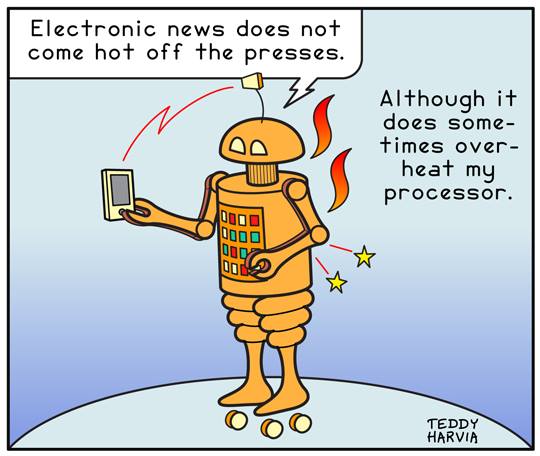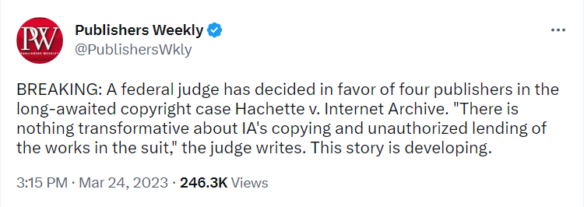

Judge Decides Against Internet Archive
source link: https://file770.com/judge-decides-against-internet-archive/
Go to the source link to view the article. You can view the picture content, updated content and better typesetting reading experience. If the link is broken, please click the button below to view the snapshot at that time.

Judge Decides Against Internet Archive

Publishers Weekly has tweeted breaking news about a decision in the publishers’ suit against the Internet Archive:

A copy of the decision can be downloaded from CourtListener: gov.uscourts.nysd.537900.188.0.pdf (courtlistener.com)
EXCERPTS FROM THE DECISION. John G. Koeltl, District Judge of the U.S. Southern District of New York, granted summary judgment based on the record, as was requested by both sides. His analysis of the case is illustrated in the following quotes from the decision.
The plaintiffs in this action, four book publishers, allege that the defendant, an organization whose professed mission is to provide universal access to all knowledge, infringed the plaintiffs’ copyrights in 127 books (the “Works in Suit”) by scanning print copies of the Works in Suit and lending the digital copies to users of the defendant’s website without the plaintiffs’ permission. The defendant contends that it is not liable for copyright infringement because it makes fair use of the Works in Suit.
…In the two years after the NEL, IA’s user base increased from 2.6 million to about 6 million…. As of 2022, IA hosts about 70,000 daily ebook “borrows.” …
…IA argues, however, that this infringement is excused by the doctrine of fair use. This doctrine allows some unauthorized uses of copyrighted works “to fulfill copyright’s very purpose, ‘[t]o promote the Progress of Science and useful Arts.’” Campbell v. Acuff-Rose Music, Inc., 510 U.S. 569, 575 (1994). While rooted in the common law, fair use is a statutory exception to copyright infringement. The Copyright Act of 1976 provides that “the fair use of a copyrighted work” for “purposes such as criticism, comment, news reporting, teaching (including multiple copies for classroom use), scholarship, or research, is not an infringement of copyright.” Id. § 107. “In determining whether the use made of a work in any particular case is a fair use,” the Copyright Act directs courts to consider the following factors:
(1) the purpose and character of the use, including whether such use is of a commercial nature or is for nonprofit educational purposes;
(2) the nature of the copyrighted work;
(3) the amount and substantiality of the portion used in relation to the copyrighted work as a whole; and
(4) the effect of the use upon the potential market for or value of the copyrighted work. 17 U.S.C. § 107. The four factors are not exclusive, but each must be considered in a “case-by-case analysis,” with the results “weighed together[] in light of the purposes of copyright.” Fox News Network, LLC v. TVEyes, Inc., 883 F.3d 169, 176 (2d Cir. 2018). Fair use presents a mixed question of law and fact and may be resolved on summary judgment where, as here, the material facts are undisputed.
FIRST FACTOR. In this Circuit, consideration of the first factor focuses chiefly on the degree to which the secondary use is “transformative.” Id. A transformative use “adds something new, with a further purpose or different character, altering the first with new expression, meaning, or message, rather than merely superseding the original work.”
…There is nothing transformative about IA’s copying and unauthorized lending of the Works in Suit.7 IA does not reproduce the Works in Suit to provide criticism, commentary, or information about them. See 17 U.S.C. § 107. IA’s ebooks do not “add[] something new, with a further purpose or different character, altering the [originals] with new expression, meaning or message.” Campbell, 510 U.S. at 579. IA simply scans the Works in Suit to become ebooks and lends them to users of its Website for free. But a copyright holder holds the “exclusive[] right” to prepare, display, and distribute “derivative works based upon the copyrighted work.” 17 U.S.C. § 106. An ebook recast from a print book is a paradigmatic example of a derivative work. Authors Guild v. Google, Inc., 804 F.3d 202, 215 (2d Cir. 2015) (”Google Books”) (citing 17 U.S.C. § 101). And although the changes involved in preparing a derivative work “can be described as transformations, they do not involve the kind of transformative purpose that favors a fair use finding.”…
The first factor also directs courts to consider whether the secondary use “is of a commercial nature or is for nonprofit educational purposes.” 17 U.S.C. § 107(1)…
…IA exploits the Works in Suit without paying the customary price. IA uses its Website to attract new members, solicit donations, and bolster its standing in the library community…. Better World Books also pays IA whenever a patron buys a used book from BWB after clicking on the “Purchase at Better World Books” button that appears on the top of webpages for ebooks on the Website…. IA receives these benefits as a direct result of offering the Publishers’ books in ebook form without obtaining a license. Although it does not make a monetary profit, IA still gains “an advantage or benefit from its distribution and use of” the Works in Suit “without having to account to the copyright holder[s],”… The commercial-noncommercial distinction therefore favors the Publishers….
IA makes a final argument that the first factor favors fair use because, according to IA, by reproducing and distributing only ebook editions of print books that were lawfully acquired, IA furthers the goals of copyright’s “first sale” doctrine. This argument is without merit….
… Acknowledging this, IA refashions a first sale argument within its fair use analysis. IA argues that although “Section 109 does not expressly encompass the reproduction right, neither does it abrogate the common-law principle favoring the ability of the owner of a copy to freely give, sell, or lend it.”…. But IA points to no case authorizing the first recipient of a book to reproduce the entire book without permission, as IA did to the Works in Suit….
… Nor does IA’s promise not to lend simultaneously its lawfully acquired print copies and its unauthorized reproductions help its case. As an initial matter, IA has not kept its promise. Although the Open Library’s print copies of the Works in Suit are non-circulating, IA concedes that it has no way of verifying whether Partner Libraries remove their physical copies from circulation after partnering with IA…. To the contrary, IA knows that some Partner Libraries do not remove the physical books from their shelves, and even if a Partner Library puts a physical book into a non-circulating reference collection, it could be read in the library while the ebook equivalent is checked out….
… The crux of IA’s first factor argument is that an organization has the right under fair use to make whatever copies of its print books are necessary to facilitate digital lending of that book, so long as only one patron at a time can borrow the book for each copy that has been bought and paid for. See Oral Arg. Tr. 31:10-15. But there is no such right, which risks eviscerating the rights of authors and publishers to profit from the creation and dissemination of derivatives of their protected works….
The first fair use factor strongly favors the Publishers…
SECOND FACTOR. The second fair use factor directs courts to consider “the nature of the copyrighted work.”
…IA argues that because most of the Works in Suit were published more than five years before IA copied them, IA has not interfered with the authors’ “right to control the first public appearance of [their] expression.”… Published works do not lose copyright protection after five years….
THIRD FACTOR. Under the third fair use factor, courts consider “the amount and substantiality of the portion used in relation to the copyrighted work as a whole.” 17 U.S.C. § 107(3). IA copied the entire Works in Suit and made the copies available for lending….
It is true that copying an entire work is sometimes necessary to make a fair use of the work… In this case, however, IA copied the Works in Suit wholesale for no transformative purpose and created ebooks that, as explained below, competed directly with the licensed ebooks of the Works in Suit. IA’s wholesale copying therefore cannot be excused, and the third factor weighs strongly in the Publishers’ favor…
FOURTH FACTOR. The fourth fair use factor is “the effect of the [copying] use upon the potential market for or value of the copyrighted work[s].” 17 U.S.C. § 107(4). This factor focuses on whether a secondary use “usurps the market for the [original] by offering a competing substitute.”
… In this case, there is a “thriving ebook licensing market for libraries” in which the Publishers earn a fee whenever a library obtains one of their licensed ebooks from an aggregator like OverDrive…. This market generates at least tens of millions of dollars a year for the Publishers…. And IA supplants the Publishers’ place in this market. IA offers users complete ebook editions of the Works in Suit without IA’s having paid the Publishers a fee to license those ebooks, and it gives libraries an alternative to buying ebook licenses from the Publishers. Indeed, IA pitches the Open Libraries project to libraries in part as a way to help libraries avoid paying for licenses….
… It is also irrelevant to assessing market harm in this case that IA and its Partner Libraries once purchased print copies of all the Works in Suit. The Publishers do not price print books with the expectation that they will be distributed in both print and digital formats,…
… Finally, the Court must consider “the public benefits [IA’s] copying will likely produce.” Andy Warhol Found., 11 F.4th at 50. IA argues that its digital lending makes it easier for patrons who live far from physical libraries to access books and that it supports research, scholarship, and cultural participation by making books widely accessible on the Internet. But these alleged benefits cannot outweigh the market harm to the Publishers….
SUMMARY ANALYSIS. … Each enumerated fair use factor favors the Publishers, and although these factors are not exclusive, IA has identified no additional relevant considerations. At bottom, IA’s fair use defense rests on the notion that lawfully acquiring a copyrighted print book entitles the recipient to make an unauthorized copy and distribute it in place of the print book, so long as it does not simultaneously lend the print book. But no case or legal principle supports that notion. Every authority points the other direction. Of course, IA remains entitled to scan and distribute the many public domain books in its collection. See Pls.’ 56.1 ¶ 294. It also may use its scans of the Works in Suit, or other works in its collection, in a manner consistent with the uses deemed to be fair in Google Books and HathiTrust. What fair use does not allow, however, is the mass reproduction and distribution of complete copyrighted works in a way that does not transform those works and that creates directly competing substitutes for the originals. Because that is what IA has done with respect to the Works in Suit, its defense of fair use fails as a matter of law. …
Recommend
About Joyk
Aggregate valuable and interesting links.
Joyk means Joy of geeK